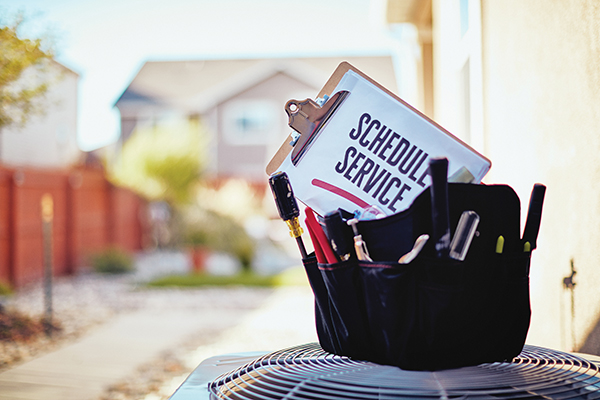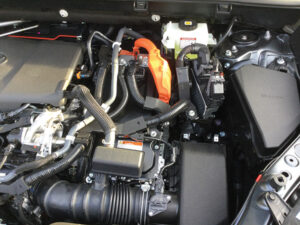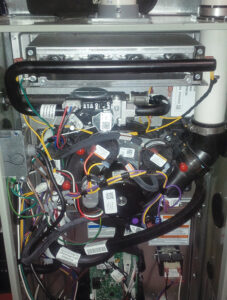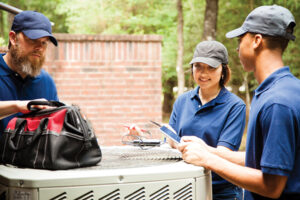
Selling Service: It’s What We Do!
March 22, 2023 | By Ian McTeer
We know the importance of regular maintenance, and it’s time we make homeowners aware of it too.

(Getty Images)
It was not the threat of global cooling (a popular theory in the 1970’s) nor today’s concern with climate change and global warming that initially led to so much interest in improving the energy efficiency of mechanical equipment powered by fossil fuels, such as automobiles and residential heating and cooling systems among so many other things.
No, it became clear to the U.S. Department of Energy in 1973 that dependence on foreign sources of energy were threatening the American economy and way of life, and that’s what drove the efficiency innovations in the 1970’s and it continues to be a touchstone for today’s HVAC industry.
While I am in full accordance with the noble goals set forth by scientists and engineers aiming at reducing the need for supplementing our domestic energy production, I am also concerned about the increasing complexity of modern machinery and its voracious appetite for system designers, installers, technicians, and support staff ranging from production workers to parts personnel, inspectors and so on.
It is a great industry we have, and I am glad it employs so many people in every area, yet I hear almost every day about staff shortages and lack of skilled trades to care for complex systems.
This dilemma not only makes life difficult for contractors and equipment owners, but it also means that poor HVAC units are being left unloved for far too long. Many units are serviced only after a breakdown that might have been prevented thanks to a well-timed annual service.
Sophistication Rules
I owned a 1964 Chevrolet Impala SS; I bought it used from a dentist in 1976.
I could do all the maintenance, but when the body finally rotted out, I sold the engine and transmission to a Chevy enthusiast—he might still be running those parts today.

Figure 1. My car.
When I look under the hood of my latest vehicle, my blood runs cold. I can identify the oil dipstick and windshield washer bottle, not much else. (Figure 1)
Mother Nature does not part with her secrets easily, squeezing every possible Btu/h out of a modern premium gas furnace requires continual monitoring by computer-controlled sensors and an ultramodern smart thermostat.
A modern heating or cooling appliance looks nothing like the crude devices once inhabiting many basements when fuel was cheap and houses were leaky.
I never would have guessed the belt-driven standing pilot furnace of days gone by would morph into something like that depicted in Figure 2.

Figure 2. Inside a modern furnace.
So, of course, I bought an extended warranty for my latest automobile, supplemented by the dealer’s maintenance offering providing oil changes along with other necessary services over a 48-month period, a program that I will likely renew when the time comes.
However, when it comes to residential HVAC, many home owners apparently prefer to take their chances when it comes to system maintenance. I read an interesting study of HVAC system breakdowns conducted by American Home Shield (AHS), a third-party warranty service provider.
Using data the company acquired from the U.S. Census Bureau, I selected their study of the city of Detroit over the winter of 2021-2022. According to the data:
- The number of occupied units with heating equipment was approximately 1.7 million.
- Reported share of homes considered to be uncomfortably cold for more than 24 hours: 7.7%.
- Top reason for heating failures: equipment breakdowns at 46.2%.
- Utility interruptions and other factors accounted for the rest.
For whatever reasons, more than 130,000 people in Detroit, at various times that winter, had no heat for more than 24 hours.
I’m reasonably certain that Detroit’s pattern of equipment breakdowns is a workable template for cold climates. Remember, the purpose of maintenance is to prevent breakdowns, so make time for maintenance otherwise it’ll make the time for you!
Selling Maintenance
HVAC sales professionals often use a soft selling technique in which the potential client takes part in an interview answering questions related to what they expect from their comfort system. Ideally, the salesperson will show how top-of-the-line premium equipment can fulfill all the homeowner’s expectations.
This technique is important, because it exposes the client to every possible option and how such refinements might be extraordinarily beneficial.
As it turns out, the princely price of such a wonderful system may be a strong objection for some, thus the salesperson can remove options and accessories until the price is no longer a barrier and hopefully they secure the sale.
One item that should remain in any sales proposal, in my opinion, is a maintenance package.
Leveraging longer manufacturer’s limited warranties, even those offering labour compensation or guaranteed equipment replacement in the event of catastrophic failure, contractors should stress the need for annual service visits that might include no charge consumable replacements such as air filters, humidifier panels and condensate neutralizers.
Admittedly, even an exceptional maintenance package proposal may be left behind in the whirlwind of the dealmaking simply because the prospective client thinks brand new equipment must be immune from failures.
When it comes to new residential construction, homebuilders in Quebec, British Columbia, Ontario and Alberta must provide buyers with a third-party warranty protecting them against major structural defects along with strictly defined deficiencies in materials and labour.
Mechanical systems installed in Ontario homes are not covered by Tarion (the group empowered to administer and enforce the Ontario New Home Warranties Plan Act and Regulations). This leaves the homeowner to deal with a busy heating contractor often providing less-than-ideal coverage based solely on an equipment manufacturer’s guarantees that may or may not include labour and travelling time.
Thus, in my opinion, new home builders and renovators should partner with HVAC contractors and offer service and maintenance contracts at the point of sale. Build in the cost of a two-year, no charge maintenance including necessary consumables.
Pride of Home Ownership
According to Statistics Canada, Canadians continue to cherish ownership of a single-family detached house. In 2016, said houses represented 53.6%, or 7.5 million, of the occupied private dwellings in Canada.
Apartments, duplexes and “other” types of buildings made up the rest of Canada’s housing stock; all of these “other” occupied residential buildings also have heating systems needing maintenance it should be noted.
Ontario accounts for roughly 4.8 million detached houses, but I have no data on how many receive regular maintenance.
I often see advertisements from the larger service providers offering maintenance plans typically on television or online, and I’m aware that some residential HVAC contractors do offer maintenance, even front loading a year or two of no cost maintenance into their sales programs, which is a good thing.
What About the Orphans?
I do not want to even guess how many stranded HVAC systems there might be across the country surviving solely on a lick and a promise, or chugging along with total breakdown only a thread away.
This is when the service technician should take the lead and present a maintenance strategy to the homeowner.
I know some technicians are loath to do any selling, be it equipment or maintenance. Yet, many homeowners will trust the words of a qualified technician and will follow good advice.
However reluctant to sell, every tech should know revenue streams created by add-on sales or maintenance contracts help to keep a company growing thus providing better benefits and hiring more employees.
At the minimum, a service tech should leave behind a sell sheet explaining the value of regular maintenance.
Here are 12 tips for creating technician-based leave-behind maintenance plan literature:
- Emphasize the benefits of regular maintenance, such as maintaining advertised efficiency and improved equipment longevity.
- Explain how the plan will provide peace of mind as it includes 24/7 emergency service and priority scheduling.
- Have examples demonstrating the cost savings of your plan(s) over time as compared to piecemeal multiple repairs.
- Scheduled appointments and automatic service reminders make servicing more convenient.
- Customer concerns about frequent repairs, high energy bills or poor heating and cooling performance might require further investigation and a more sophisticated plan, let the customer know you can help improve their existing system.
- Offer a discounted rate for a new sign-up.
- Offer a free consultation for equipment replacement or system tune-up that might require extensive renovations.
- Offer a discount on accessory sales such as equipment surge protection, condensate neutralizers, humidifier panels, upgraded compressor contactors and air filters.
- Offer a satisfaction guarantee or go one step further, a money-back guarantee.
- The company will provide references or testimonials from satisfied customers nearby who purchased a service plan.
- The company technicians attend regular training and are fully licensed in the HVAC industry.
- The company strives to embrace the latest technology including updated energy efficiency standards and safety requirements.
Now Comes the Hard Part

(Getty Images)
As mentioned, I cannot say how many of the millions of heating systems across Canada receive annual maintenance. Having said my piece, extolling the virtues of annual maintenance, the real problem is the lack of personnel to do all this servicing.
We all know the trades are looking for new apprentices. Governments, federal and provincial, are encouraging youth to consider taking up a trade, but it seems there are not enough potential tradespeople coming online fast enough, especially in HVAC.
Sometimes, governments fumble the process of addressing the concerns of emerging apprentices to the point of discouragement, even despair.
Recently, I read some remarks on social media about the 313D residential air conditioning systems mechanic/technician program in Ontario that shocked me.
A young woman, Shawna Peddle, was training to become a qualified professional 313D technician. However, Shawna had to leave the program because her community college was unable to offer the necessary classroom learning component of her program.
She wrote: “The 313D apprenticeship is supposed to be 2.5 years long, composed of 4,500 hours and two mandatory school blocks at an accredited college. Two years into my apprenticeship it came to light that Ontario rarely if EVER offers the second school block. The Ministry stated this is due to ‘lack of bodies’”.
She goes on to say, “You cannot complete an apprenticeship without completing the school blocks… defeating the entire purpose of the apprenticeship, leaving apprentices in limbo with no end in sight.”
What’s even worse, Shawna left the 313D program!
Residential HVAC will suffer with the loss of even one apprentice.
It took decades of discussions between the Ministry of Labour, the labour unions, HVAC industry organizations like HRAI and employers to finally establish the 313D ticket. This is heartbreaking.
Good for her, she landed on her feet in the 313A refrigeration and air conditioning systems mechanic license program as a third-year apprentice and writes: “I love my career in HVAC/R, the skilled trades are an incredible industry brimming with opportunities. We are currently facing a massive gap in our workforce and the apprentices we so badly require NEED A SYSTEM THAT WORKS!”
Victor Hyman, executive director at ClimateCare Canada noticed her post and chimed in with, “ClimateCare Canada has been working with St. Lawrence College to get the first dedicated 313D program set-up. The program application has letters of support from numerous Ontario colleges who offer 313A/D programs and realize that what is needed is a dedicated 313D program that will consistently run level 2 courses – and not during AC season!”
However, there is a fumble, says Victor, “Unfortunately, the application with the Ministry is held up in red tape for no discernible reason. We need to professionalize the resident HVAC trade if we are going to meet our decarbonization and residential new construction goals.”
Echoing Victor’s words, only proper specification, installation, commissioning and annual maintenance will insure all our sophisticated modern equipment will continue to operate as advertised.
Apprentices, HVAC industry business owners and interested persons alike across Canada should send an email to their local MPPs or MLAs encouraging them to implement, or to improve, existing apprenticeship programs before the wheels completely fall off industry efforts to conserve our precious resources. <>

 Ian McTeer is an HVAC consultant with over 35 years of experience in the industry. He was most recently a field rep for Trane Canada DSO. McTeer is a refrigeration mechanic and Class 1 Gas technician. For questions or comments, Ian can be reached at imcteer@outlook.com.
Ian McTeer is an HVAC consultant with over 35 years of experience in the industry. He was most recently a field rep for Trane Canada DSO. McTeer is a refrigeration mechanic and Class 1 Gas technician. For questions or comments, Ian can be reached at imcteer@outlook.com.


